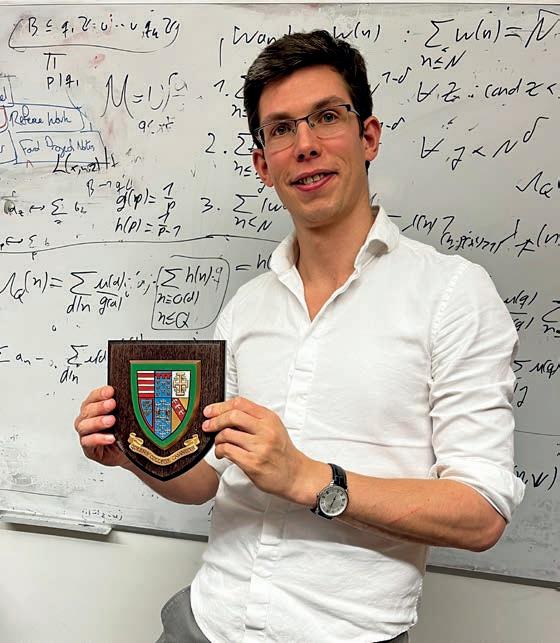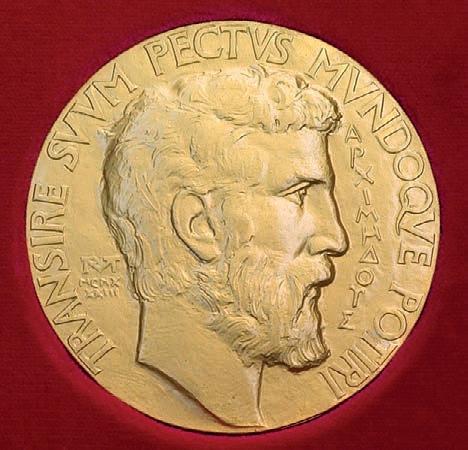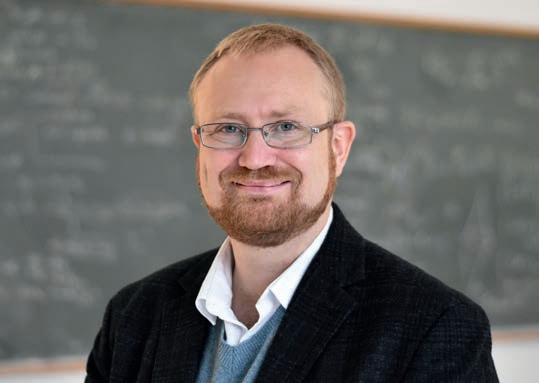
4 minute read
The College’s first Fields Medal winner
Professor James Maynard (2005)
In July last year, James won the Fields Medal, one of the most prestigious prizes in Mathematics, akin to a Nobel Prize. Awarded every four years since 1936, it recognises ‘outstanding mathematical achievement for existing work and for the promise of future achievement.’
Advertisement
James travelled to Helsinki to attend the ceremony, which is part of the International Congress of Mathematicians run by the International Mathematical Union (IMU). Only four mathematicians under the age of 40 are awarded a Medal each time. James’s work is described in his citation for the Medal as ‘highly ingenious, often leading to surprising breakthroughs on important problems that seemed to be inaccessible by current techniques.’

The Bridge caught up with James in his office at the Mathematical Institute in Oxford, where he is now Professor of Number Theory.
“It was an interesting week: was awarded the Medal and my son was born! Life hasn’t changed too much except that my inbox is exploding”, he says. His passion is Mathematical research so he is keen to preserve the ability to work and 90% of his time is spent on this. “The Medal buys a safety net and reassurance… as a junior academic, one is always trying to impress seniors and move on up”. Now, though, he is able to attract new people to the Institute and to nurture students and postdocs. “I do get asked for the occasional photo by undergraduates in lectures.”
His current college, St John’s, has also commissioned a portrait of him.
Back to the start – why Queens’?
“Perhaps had some experience of Queens’ through my father (Chris, 1970) and this made Cambridge less intimidating. I knew Queens’ had a lively social reputation and it was welcoming and friendly.”
James was interviewed by Professor Andrew Glass on Number Theory – something James had put down on his UCAS form as an interest of his – “quite a brave thing to do, as I hadn’t been taught it.” Professor Stuart Sage (1981) also interviewed him.

James remembers fondly that the Mathematics Fellows consciously pushed this license to explore and be a free thinker. “I was less good, therefore, at getting my homework problems in on time.” There were separate supervisions organised for him which proved to be a double-edged sword as “I was doubling my workload but also wanted to have fun.”
He describes himself at the time as being naïve without “vision of self” – he knew he was very passionate about Mathematics – it just wasn’t clear how successful he could or would be. James suspects he was in the top ten in the Tripos Finals but was not fixated on being Senior Wrangler.
“The career stages appeared naturally rather than as some grand, strategic plan.” Part III Mathematics was followed by a DPhil in Prime Numbers at Balliol; at the end of this, he knew he wanted to be an academic and do research on Prime Numbers.
Work-life balance
“I can switch off, particularly when I’m attending to my baby son.” But often, at the back of his mind, a solution to another problem is germinating and he knows he must get back to work. In the next few years, he most looks forward to continuing his research and bringing new faces to the table.
When did you find your particular area of interest, the distribution of prime numbers and the gap between them?
I always had an interest in Mathematics and a clear passion for Number Theory; my career just developed rather than following some pre-destined path. I knew that being a Mathematician was the job wanted, even though one doesn’t know the reality of the life and career [that goes with it].
The interest comes from the fact that there are lots of things with prime numbers that you can explain to a school-age child but there are also problems that have not been solved for hundreds of years. And, there are lots of bits of theories drawn into the subject of prime numbers.
Your work is a significant step towards the Twin Prime Conjecture, which asserts that there are infinitely many twin primes, i.e. pairs of primes that differ by two. How far away are we from a proof of this? Is there one fundamental obstacle or are there many? It needs some big breakthroughs and will not be solved any time soon –but perhaps one more big idea will create the momentum required.
The Fields Medal citation mentioned your creativity and ingenuity; so what does it mean to you to be creative as a mathematician?
Sometimes the ideas come subconsciously leading to moments of great frustration; but then on a walk home or in the shower, the solution comes. It’s mysterious and remarkable to me. But, one needs to be in the right frame of mind and have the space to come up with the ideas.
The way of thinking is this: 1) distil the ideas into simpler ‘model’ problems and 2) then build up an intuition about it. Finding the right thing in the first place is the problem.
How motivated are you by the usefulness of the mathematical research you are doing i.e. its real-world application?
I have to do research that I think is worthwhile. I view the research as fundamental to the universe and the natural world we live in – wouldn’t enjoy it otherwise. But this is not the motivation. I must feel that what I’m doing is important.
What is the connection between the mathematics you were doing at Queens’ and what you are doing now?
I was what you might call an independently-minded student and was not always the most dutiful! But that essential freedom at Queens’ set me up really well for my later career. That’s the main thing took away.
What advice would you have for current undergraduate mathematicians at Queens’?
They need to follow their interest and work on what they find fun. Much of being a mathematical researcher is making zero progress, so it could be very depressing! But if you can enjoy it, then it is perfect.
To watch James’s award video from the IMU ceremony, scan the QR code or visit http://bit.ly/3KowRfW










